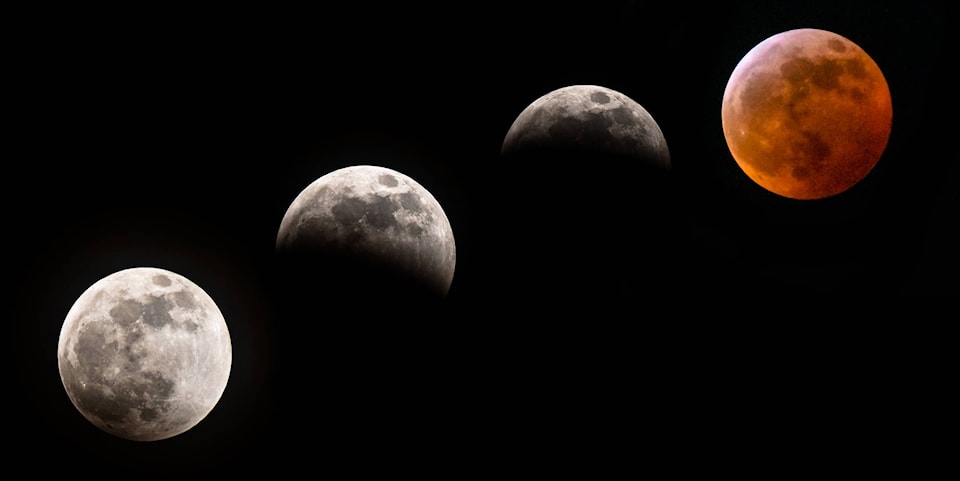Last Sunday’s lunar eclipse was pretty cool.
Like so many others, I couldn’t help but venture outside and look up into the nighttime sky to watch as the shadow of the Earth crept across the surface of the moon.
This particular type of eclipse is most often referred to as a blood moon, although the term blood moon is not really a scientific term. It occurs when a full moon is completely within the dark umbral shadow cast into space by planet Earth and the only sunlight able to reach the moon is red light that has been filtered and refracted by the Earth’s atmosphere.
This causes the moon to appear shrouded in an eerie, bloody red colour.
One can only speculate what our early ancestors might have thought of a blood moon eclipse. We do know from archaeological evidence that the sun, moon and stars did play a significant role in their everyday lives.
The earliest historical records of astronomical measurements date back to Mesopotamia of 5000 years ago. Observations were also made by the ancient Babylonians, Greeks and Chinese.
Related: Super blue blood moon coming to skies near you
Many of these early societies believed the affairs of man were, indeed controlled by the movement and positions of the sun, moon, stars and planets. Although astrology is now more or less regarded as a pseudo science, it was the original incentive for the mapping of the stars and assignment of names for the constellations.
Astronomy today has become much more than the simple mapping of stars and planets into outlines of mythological gods and magical creatures, it is the scientific study of the contents of the entire universe as we know it, with all its stars, planets, comets, asteroids, nebulae, galaxies and unknown wonders that lie beyond.
The past few years have given us some truly awe-inspiring and wondrous astronomical phenomena. Some have been easily observed with the naked eye while others required the use of a telescope.
Observing the night sky with the naked eye requires little more than taking the time to look up – that and a clear night. The use of a simple star chart or map of the sky will enable you to determine what you are actually looking at. You can download star charts free from the Internet.
Related:Super blue blood moon from Haida Gwaii
Once you look through a telescope though, everything changes - a whole new wondrous world literally opens up right in front of your eyes. Even more wondrous, is when you consider the fact that the stars you see through your telescope appear as they were hundreds of thousands of years ago. What you are seeing is reflected light that has travelled though time and space for millennia until reaching planet Earth. What you are seeing may have, in actual fact, ceased to even exist tens of thousands of years ago.
It took the invention of the telescope to develop astronomy into the modern science of today. It may seem strange to us now, but for most of recorded history, it was believed the Earth, not the sun, was the centre of the universe. A Polish mathematician by the name of Nicolaus Copernicus first asserted the theory that the Earth was, in fact, not the centre of the universe, but rather the Earth that rotated on its own axis once daily and travelled in an orbit around the sun once annually. And, it wasn’t until several years after the invention of the refracting telescope in Holland, that an Italian astronomer by the name of Galileo Galilei was able to validate the “unholy” idea that the Earth orbited the sun and the sun was, in actual fact, the centre of the solar system.
For his efforts, Galileo was tried for heresy, forced to recant his support of Copernicus’ theory and was subsequently sentenced to spend the rest of his life under house arrest. All this took place, ironically, during the Age of Enlightenment.
Ever since Galileo first pointed his telescope towards the planets, we have been asking questions and searching for answers. In the process of finding answers, we have managed to set foot on the moon, built the Hubble telescope and have begun to send exploratory craft to other planets.
And all because a few early astronomers looked up at the night sky and asked the simple question: why?
• An interesting side note to Sunday’s lunar eclipse is the fact astronomers looking through telescopes observed a meteorite striking the moon during the eclipse. This may be the first time such an impact has been recorded during a lunar eclipse.
@SalmonArm
barb.brouwer@saobserver.net
Like us on Facebook and follow us on Twitter
